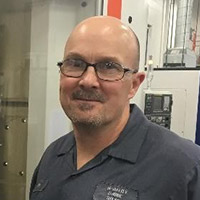With over 30 years of commitment to the wire EDM community, ESPRIT is widely recognized as the market leader in CAM for wire EDM. Decades of collaboration have led to innovative solutions optimized for individual wire EDM brands and machines.
- Solutions optimized for individual wire EDM brands and machines
- Expert systems that apply proven, machine-specific knowledge of cutting conditions
- Factory-developed post processors that deliver edit-free G-code
Universal Machining
With its universal machining cycles, ESPRIT is the right choice for all wire EDM programming, including dies and punches for the tool and die industry, cavities and inserts for mold making, medical components, and general mechanical parts. These machining cycles offer all-in-one support for the complete EDM process including wire and tank controls, rough cutting, tab and slug handling, and finish skim cutting.
- All-in-one support for the complete EDM process
Contouring
Contouring is the most flexible and commonly used cycle. It offers straight cutting, taper cutting, and parts with land and relief. By supporting advanced conic programming, this cycle automatically machines geometry with advanced taper changes and corner styles (conical, cylindrical, and programmed radii). The 4-axis contouring cycle uses two synchronized profiles: an upper UV profile and a lower XY profile. Synchronization points provide control over the exact geometry and surfaces produced by the machining process.
- 2-axis, land and relief, and taper cuts
- Advanced conic programming
- 4-axis synchronized profiles: XY and UV
Pocketing, No-Core Cutting
When a slug is too small or too intricate to easily remove, use the no-core pocketing cycle to remove the material inside a given cavity without creating a slug. No-core pocketing is available for 2-axis and 4-axis wire EDM with a variety of machining patterns to efficiently remove material inside virtually any shape. ESPRIT recognizes and automatically machines only the slug, which prevents wire breakage and minimizes machining time.
- Slugless pocketing in 2-axis and 4-axis
- Patterns to efficiently remove material inside any shape

Machine-Optimized Programming
As a machine-optimized CAM system, ESPRIT offers solutions individually tuned for each wire EDM machine model. With ESPRIT, quickly move with confidence from design to finished part while reducing programming and setup time, cycle times, and operator supervision.
- Machine-optimized, edit-free G-code
Advanced EDM Strategies
ESPRIT's pocketing and contouring cycles offer extensive control over the cutting paths to provide the required part quality while minimizing cutting time and eliminate wire breakage. This includes application-specific functionality for punches and dies, mold inserts, land and taper cutting, and slug control. Other advanced functionality includes the addition of reliefs and special motions for sharp internal and external corners, entry and exit techniques that eliminate witness lines, and automatic corner rounding. To improve cycle time when performing multiple cuts, ESPRIT will alternate the direction of each cut instead of returning the wire to the start point at the beginning of each pass.
- Minimizing cutting time and eliminate wire breakage
- Application-specific functionality for punches and dies, mold inserts, land and taper cutting, and slug control
Rotary EDM
Adding a rotary axis to a wire EDM allows the machining of multi-sided parts in a single setup. A rotary axis also increases the variety of shapes that can be cut because the machine can combine simultaneous linear and rotary motion. ESPRIT supports indexing, turning, and simultaneous cutting for all EDM machines that support rotary motion.
Three types of rotary capabilities are available in ESPRIT:
- Turn-then-burn (rotating the workpiece into position before cutting begins)
- Turn-while-burn (rotating the workpiece during the cut)
- EDM turning (spinning the workpiece like a lathe during the cut)
Unattended Machining
With G-code programs that minimize operator supervision, ESPRIT allows wire EDM machines to run unattended for extensive periods of time. To accomplish this, ESPRIT classifies the operations into roughing, skimming, and cut off, and then optimizes the sequencing of these operations across multiple features and workpieces. Slug management, pocketing with slugless burning, and additional tabs for larger workpieces further reduce the need for operator intervention. With this combination of optimally sequenced cuts and slug management, along with automatic wire cutting and re-threading, the machine runs longer with less supervision.
- Roughing, skimming, and cut off optimized across multiple features and workpieces
- Slug management with slugless burning
- Additional tabs for larger workpieces
Model-Driven EDM
To dramatically simplify the programming process, model-driven machining automatically extracts information directly from the original part geometry to create a machineable feature. This information includes the initial wire thread location, the start point on the profile, cut direction, taper angles, the height of any land area, corner styles, and, optionally, any 4-axis synchronization. The resulting features contain all the geometric information necessary to drive the contouring and pocketing cycles, with an automatic classification of parts that can be machined in 2-axis versus those that require 4-axis.
- Wire path directly from the CAD model
- Automatic classification of 2- versus 4-axis parts
SolidWire Cycles
Contouring, 2-axis with Advanced Conics
- Offering separate rough and skim strategies for tapered and straight walls. Between cuts, ESPRIT automatically handles all the necessary wire-cut and wire-thread instruction
Pocketing, 2-axis No-Core
- When the size or shape of a cavity makes it difficult to efficiently handle slugs (cores), this cycle erodes away all the material inside a cavity without creating a slug
4-axis Contouring
-
Erosion-driven using independent upper (UV) and lower (XY) profiles that may include synchronization at any point during the cut with roughing, tab management, and optional skim cutting
4-axis No-Core Pocketing
- Using a 2-axis toolpath to cut the largest area that can be removed as a slug, followed by 4-axis no-core movements to erode the remaining material that cannot be removed as a slug; or a full 4-axis no-core pocket for the entire cavity without creating a slug
Rotary EDM
- Turn-then-burn (indexing): Contouring or pocketing using a rotary axis at a fixed angle
- Turn-while-burn: Contouring with a continuous rotation of the workpiece while the wire is burning.
- Spin and burn: Similar to lathe turning, removing the material by feeding a wire, instead of a tool, along a rotating workpiece to produce axially symmetric shapes
- Turn facing: Roughing using a series of index angles around the workpiece followed by a contouring cycle removing the stock. Material is removed in large pieces allowing for easy recovery and recycling
- Turn contouring: A finishing cycle that spins the workpiece using a rotary axis while contouring in 2-axis
EDM Drilling (Hole Popper)
-
Hole drilling using an electrode for the precise machining of small-diameter holes
Manual EDM
- Creates a wire EDM operation with rapid and/or feed movements along manually selected geometry
Optional Specialized Modules
- Gear Generator
- CAM Generator

